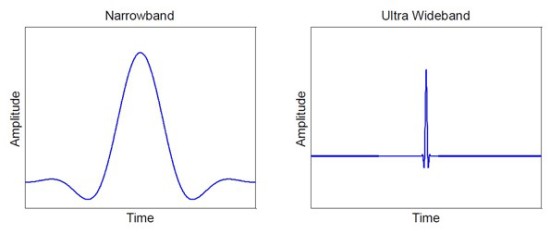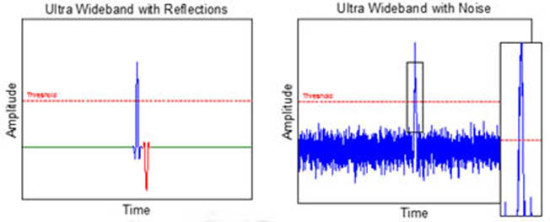UWB Technology

The Sewio’s RTLS platform is based on the DW1000 Integrated Circuit chip from DecaWave. The chip utilizes the Ultra Wideband technology in order to bring decimeter level positioning to the market. Unlike traditional radio technologies (like Bluetooth or Wi-Fi), UWB operates with the signal’s so-called Time of Flight rather than RSSI (Received Signal Strength Indication), which makes the technology much more precise and enables it to make very exact ranging measurements. This opens up new opportunities in several business verticals, that have simply not been possible before.
Key Features of UWB Technology
- High localization precision (decimeter-level)
- No interference with other radio communication systems
- Resistant to multipath signal propagation
- Resistant to noise
- Use of low power transceivers
IEEE 802.15.4a Standard
IEEE 802.15.4a standard (2007) is an amendment to the original 802.15.4 standard from 2006. It defines both the MAC (link) and PHY (physical) layers from the ISO/OSI reference model. The original standard introduced new ways for communications in small WPAN (Wireless Personal Area Networks) networks with short range and low data rates. These technologies, such as ZigBee for instance, are great for building up so-called Wireless Sensor Networks (WSN). The 802.15.4a amendment added two new PHYs into the standard: CSS and Ultra Wideband. These additions introduced new features that the original standard was lacking: higher data throughput and also the feature of very precise ranging gained by the UWB PHY.
In 2011 the IEEE 802.15.4–2011 revision was introduced and it serves as a revision of the original standards in order to roll them all into a single document. The standard specifies three frequency bands, the sub-gigahertz, the low and high band yielding 16 radio channels in total. Of course, it depends on each state’s regulatory office, which of these bands can or cannot be used geographically. It also specifies four data rates for the UWB PHY: 110 kbps, 850 kbps, 6.8 Mbps and 27 Mbps. The standard also shows clear support for ranging capabilities by the UWB PHY.
Ultra Wideband Signals
UWB utilizes a train of impulses rather than a modulated sine wave to transmit information. This unique characteristic makes it perfect for precise ranging applications. Since the pulse occupies such a wide frequency band, its rising edge is very steep and this allows the receiver to very accurately measure the arrival time of the signal. Plus the pulses themselves are very narrow, typically no more than two nanoseconds.
Due to the nature of the signals, UWB pulses can be distinguished even in noisy environments, plus the signals are resistant to multipath effects. All of these traits give UWB big advantage over traditional narrowband signals in case of ranging capabilities. Also due to the strict spectral mask, the transmit power lies at the noise floor, which means that UWB does not interfere with other radio communication systems operating in the same frequency bands, since it just increases the overall noise floor, a principle that is very similar to spread spectrum technologies (CDMA).


DW1000 from DecaWave utilizes six radio channels in total, both in the UWB’s low and high bands. This gives the chip flexibility, since if there is some sort of interference in one channel, the chip can be easily switched to a different radio channel. Channels 1,2,3 and 5 are defined by their 500 MHz bandwidth while channels 4 and 7 offer bandwidth of over 1 GHz.
| operation frequency | bandwidth 500 MHz | number of channels 2 |
| Channel | Center Frequency (MHz) | Band (MHz) | Bandwidth (MHz) |
| 2 | 3993.6 | 3774 – 4243.2 | 499.2 |
| 5 | 6489.6 | 6240 – 6739.2 | 499.2 |
The DW1000 uses the first three data rates from the IEEE 802.15.4–2011 standard, namely 110 kbps, 850 kbps and 6.8 Mbps. For localization purposes, only the 500 MHz channels 2 and 5 are used in Sewio product line.